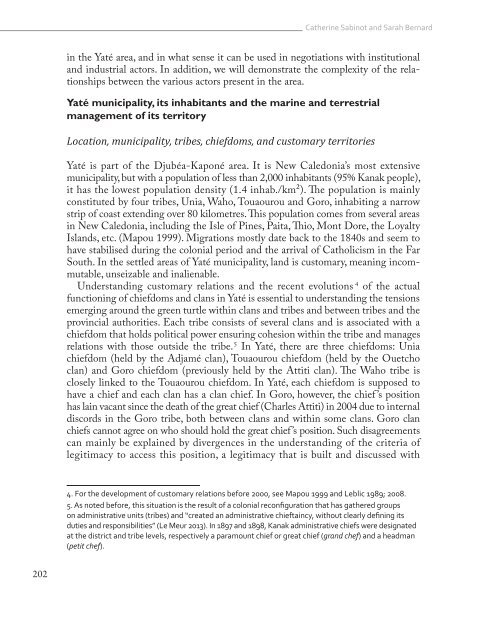Fisheries in the Pacific
Fisheries_in_the_Pacific
Fisheries_in_the_Pacific
You also want an ePaper? Increase the reach of your titles
YUMPU automatically turns print PDFs into web optimized ePapers that Google loves.
Ca<strong>the</strong>r<strong>in</strong>e Sab<strong>in</strong>ot and Sarah Bernard<br />
<strong>in</strong> <strong>the</strong> Yaté area, and <strong>in</strong> what sense it can be used <strong>in</strong> negotiations with <strong>in</strong>stitutional<br />
and <strong>in</strong>dustrial actors. In addition, we will demonstrate <strong>the</strong> complexity of <strong>the</strong> relationships<br />
between <strong>the</strong> various actors present <strong>in</strong> <strong>the</strong> area.<br />
Yaté municipality, its <strong>in</strong>habitants and <strong>the</strong> mar<strong>in</strong>e and terrestrial<br />
management of its territory<br />
Location, municipality, tribes, chiefdoms, and customary territories<br />
Yaté is part of <strong>the</strong> Djubéa-Kaponé area. It is New Caledonia’s most extensive<br />
municipality, but with a population of less than 2,000 <strong>in</strong>habitants (95% Kanak people),<br />
it has <strong>the</strong> lowest population density (1.4 <strong>in</strong>hab./km²). The population is ma<strong>in</strong>ly<br />
constituted by four tribes, Unia, Waho, Touaourou and Goro, <strong>in</strong>habit<strong>in</strong>g a narrow<br />
strip of coast extend<strong>in</strong>g over 80 kilometres. This population comes from several areas<br />
<strong>in</strong> New Caledonia, <strong>in</strong>clud<strong>in</strong>g <strong>the</strong> Isle of P<strong>in</strong>es, Paita, Thio, Mont Dore, <strong>the</strong> Loyalty<br />
Islands, etc. (Mapou 1999). Migrations mostly date back to <strong>the</strong> 1840s and seem to<br />
have stabilised dur<strong>in</strong>g <strong>the</strong> colonial period and <strong>the</strong> arrival of Catholicism <strong>in</strong> <strong>the</strong> Far<br />
South. In <strong>the</strong> settled areas of Yaté municipality, land is customary, mean<strong>in</strong>g <strong>in</strong>commutable,<br />
unseizable and <strong>in</strong>alienable.<br />
Understand<strong>in</strong>g customary relations and <strong>the</strong> recent evolutions 4 of <strong>the</strong> actual<br />
function<strong>in</strong>g of chiefdoms and clans <strong>in</strong> Yaté is essential to understand<strong>in</strong>g <strong>the</strong> tensions<br />
emerg<strong>in</strong>g around <strong>the</strong> green turtle with<strong>in</strong> clans and tribes and between tribes and <strong>the</strong><br />
prov<strong>in</strong>cial authorities. Each tribe consists of several clans and is associated with a<br />
chiefdom that holds political power ensur<strong>in</strong>g cohesion with<strong>in</strong> <strong>the</strong> tribe and manages<br />
relations with those outside <strong>the</strong> tribe. 5 In Yaté, <strong>the</strong>re are three chiefdoms: Unia<br />
chiefdom (held by <strong>the</strong> Adjamé clan), Touaourou chiefdom (held by <strong>the</strong> Ouetcho<br />
clan) and Goro chiefdom (previously held by <strong>the</strong> Attiti clan). The Waho tribe is<br />
closely l<strong>in</strong>ked to <strong>the</strong> Touaourou chiefdom. In Yaté, each chiefdom is supposed to<br />
have a chief and each clan has a clan chief. In Goro, however, <strong>the</strong> chief ’s position<br />
has la<strong>in</strong> vacant s<strong>in</strong>ce <strong>the</strong> death of <strong>the</strong> great chief (Charles Attiti) <strong>in</strong> 2004 due to <strong>in</strong>ternal<br />
discords <strong>in</strong> <strong>the</strong> Goro tribe, both between clans and with<strong>in</strong> some clans. Goro clan<br />
chiefs cannot agree on who should hold <strong>the</strong> great chief ’s position. Such disagreements<br />
can ma<strong>in</strong>ly be expla<strong>in</strong>ed by divergences <strong>in</strong> <strong>the</strong> understand<strong>in</strong>g of <strong>the</strong> criteria of<br />
legitimacy to access this position, a legitimacy that is built and discussed with<br />
4. For <strong>the</strong> development of customary relations before 2000, see Mapou 1999 and Leblic 1989; 2008.<br />
5. As noted before, this situation is <strong>the</strong> result of a colonial reconfiguration that has ga<strong>the</strong>red groups<br />
on adm<strong>in</strong>istrative units (tribes) and “created an adm<strong>in</strong>istrative chiefta<strong>in</strong>cy, without clearly def<strong>in</strong><strong>in</strong>g its<br />
duties and responsibilities” (Le Meur 2013). In 1897 and 1898, Kanak adm<strong>in</strong>istrative chiefs were designated<br />
at <strong>the</strong> district and tribe levels, respectively a paramount chief or great chief (grand chef) and a headman<br />
(petit chef).<br />
202


